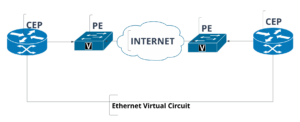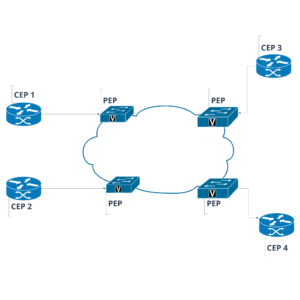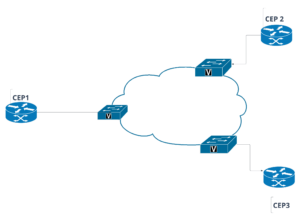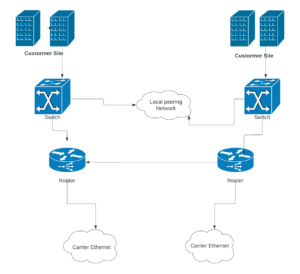In today’s rapidly evolving digital landscape, where seamless data transmission is needed for businesses, Carrier Ethernet has emerged as a game-changer. Building upon the success of Metro Ethernet . Carrier Ethernet takes networking to a whole new level.
In this article, we will delve deep into the world of Carrier Ethernet, exploring its services, architecture, standards, and much more.
What is Carrier Ethernet?
Carrier Ethernet is an Ethernet transport network that utilizes Ethernet standards to provide high-speed, reliable, and scalable wide area network (WAN) connectivity.
Unlike traditional Ethernet confined to local area networks (LANs), Carrier Ethernet extends its capabilities to encompass larger geographic areas, making it an ideal solution for enterprises and service providers.
Carrier Ethernet Services and Topologies
Under the umbrella of Carrier Ethernet, several services and topologies facilitate efficient data transmission. Let’s explore three prominent ones:
1) E-Line Service
E-Line services, also known as Ethernet Private Lines (EPL), offer point-to-point connectivity to a dedicated circuit between two locations. This service ensures secure and direct communication channels, making it suitable for applications that require strict privacy and data isolation.

E-Line in Carrier Ethernet involves two Customer Ethernet Ports (CEPs) connected by a Provider Ethernet Port (PE). The PE serves as a bridge, ensuring the encapsulation and secure delivery of Ethernet frames between the CEPs over the Carrier Ethernet network.
This point-to-point connectivity enables dedicated communication channels between two locations, facilitating secure and efficient data transmission.
2) E-LAN Service
E-LAN services, or Ethernet LAN services, enable multipoint-to-multipoint connectivity, allowing multiple locations to communicate with one another.
This service establish collaboration among geographically dispersed sites, making it a go-to solution for businesses seeking efficient interconnectivity.

E-LAN in carrier Ethernet involves multiple customer Ethernet ports (CEPs) connected to a provider Ethernet port (PEP). The PEP serves as a central hub or bridge, enabling the distribution of Ethernet frames among the various CEPs. This architecture creates a multipoint connectivity model, allowing data to be transmitted between any combination of connected locations.
Note: Unlike Metro Ethernet, which is designed for metropolitan areas, Carrier Ethernet extends its coverage to wider geographical areas, including regional, national, and even global networks.
3) E-Tree Service
E-Tree services provide point-to-multipoint connectivity, resembling a hub-and-spoke architecture. This service is well-suited for scenarios where a central location, such as a head office or data center, serves as a hub, connecting to multiple remote branches or endpoints.

Carrier Ethernet Architecture
To comprehend the inner workings of Carrier Ethernet, let’s explore its architecture, which consists of various components and elements:

- Customer Premises Equipment (CPE): At the edge of the network, Customer Premises Equipment acts as the interface between the customer’s local network and the service provider’s Carrier Ethernet network. CPE devices include routers, switches, and other networking equipment. CPE is represented with customer site in the diagram above.
- Provider Edge (PE) Devices: Provider Edge devices serve as the entry and exit points of Carrier Ethernet services. They connect the customer’s network to the service provider’s network, ensuring good data transmission. PE is represented with the two switch and routers at the center of the circuit diagram above.
- Carrier Ethernet Switches: Carrier Ethernet switches play a crucial role in Carrier Ethernet networks. They provide the necessary switching capabilities to manage and direct data traffic within the Carrier Ethernet network, enabling efficient communication between different endpoints.
Carrier Ethernet Standard
The adoption and implementation of Carrier Ethernet are facilitated by industry standards established by organizations such as the Metro Ethernet Forum (MEF)
Key Attributes of Carrier Ethernet
Carrier Ethernet boasts of several key attributes that differentiate it from traditional networking technologies. Let’s explore them:
- Standardized Services: Carrier Ethernet provides standardized services, ensuring consistent quality and performance across different networks and service providers.
- Scalability: Carrier Ethernet’s inherent scalability allows networks to expand effortlessly, accommodating increasing bandwidth demands. This scalability enables businesses to adapt and grow without compromising network performance.
- Reliability: With Carrier Ethernet, reliability takes center stage. Service providers ensure high availability and fault tolerance through redundant links and network infrastructure. This reliability guarantees consistent data transmission, crucial for mission-critical applications.
- Quality of Service: Carrier Ethernet prioritizes Quality of Service (QoS), enabling traffic differentiation and efficient bandwidth allocation. This ensures that critical applications receive the necessary network resources, maintaining optimal performance and user experience.
- Service Management: Carrier Ethernet incorporates robust service management capabilities, allowing service providers and network administrators to monitor, control, and troubleshoot network performance.
- Service Level Agreements (SLAs): Carrier Ethernet services are typically backed by Service Level Agreements, defining performance metrics, guarantees, and penalties in case of non-compliance. SLAs ensure accountability and provide customers with assurances regarding network reliability and performance.
Emerging Trends in Carrier Ethernet
As technology advances, Carrier Ethernet continues to evolve. Several emerging trends are shaping the future of Carrier Ethernet networks. Here are some:
- Higher Speeds: With the growing need for faster data transmission, Carrier Ethernet is adapting to support higher speeds, such as 100Gbps and beyond. This trend enables businesses to keep up with escalating bandwidth requirements.
- Software-Defined Networking (SDN): The integration of Carrier Ethernet with Software-Defined Networking (SDN) allows for centralized network control and programmability. SDN simplifies network management and enables dynamic allocation of network resources.
- Network Function Virtualization (NFV): Carrier Ethernet networks are embracing Network Function Virtualization (NFV), where network functions traditionally implemented using dedicated hardware are virtualized. NFV enhances flexibility, scalability, and cost-efficiency in network deployments.
Applications of Carrier Ethernet
Carrier Ethernet finds applications across various industries, empowering critical operations and enabling innovative solutions:
- Telecommunications: Telecommunication service providers leverage Carrier Ethernet to deliver high-speed internet connectivity, Voice over IP (VoIP) services, and multimedia content distribution, among other applications.
- Healthcare: In the healthcare sector, Carrier Ethernet facilitates secure and reliable data transmission between hospitals, clinics, and medical devices. This technology supports telemedicine, electronic health records (EHRs), and medical imaging.
- Finance: Financial institutions rely on Carrier Ethernet for secure and low-latency data transmission, critical for real-time trading, high-frequency trading (HFT), and interbank communications.
- Cloud Services: Carrier Ethernet underpins the foundation of cloud services, enabling efficient connectivity between data centers and supporting cloud-based applications, storage, and computing.
Advantages of Carrier Ethernet
The adoption of Carrier Ethernet brings forth numerous advantages:
- Cost-Effectiveness: Carrier Ethernet provides cost-effective solutions compared to traditional networking technologies. With standardized services and efficient utilization of network resources, businesses can optimize their connectivity costs.
- Flexibility: Carrier Ethernet’s inherent flexibility allows businesses to adapt and scale their networks based on evolving requirements. This adaptability saves time and resources by avoiding costly network redesigns.
- Ease of Scalability: The scalability of Carrier Ethernet networks eliminates the need for frequent infrastructure upgrades. Businesses can easily increase bandwidth and expand their network capabilities as demands grow.
- Reliability and Performance: Carrier Ethernet ensures high reliability and performance, minimizing downtime and ensuring uninterrupted data transmission. This reliability is crucial for mission-critical applications and customer satisfaction.
- Simplified Network Management: The standardized nature of Carrier Ethernet simplifies network management, making it easier for IT teams to deploy, monitor, and troubleshoot networks. This streamlined management reduces operational complexities.
Limitations of Carrier Ethernet
While Carrier Ethernet offers numerous benefits, it is essential to be aware of its limitations:
- Extensive Infrastructure Requirements: Implementing Carrier Ethernet networks often requires a significant investment in infrastructure, including switches, routers, and high-quality cabling. This upfront cost can be a deterrent for some organizations.
- Skilled Network Administrators: Managing Carrier Ethernet networks necessitates skilled network administrators who understand the complexities of the technology. Acquiring and retaining qualified personnel may pose challenges for certain businesses.
Conclusion
Carrier Ethernet represents a significant leap forward in networking technology, revolutionizing the way businesses connect and communicate. With its standardized services, scalability, reliability, and QoS capabilities, Carrier Ethernet empowers organizations to thrive in the digital era.
By embracing emerging trends and exploring applications across diverse industries, Carrier Ethernet continues to reshape the landscape of network connectivity, enabling seamless and efficient data transmission.

I am a passionate Networking Associate specializing in Telecommunications.
With a degree in Electronic engineering, I possess a strong understanding of electronic systems and the intricacies of telecommunications networks. I gained practical experience and valuable insights working for a prominent telecommunications company.
Additionally, I hold certifications in networking, which have solidified my expertise in network architecture, protocols, and optimization.
Through my writing skills, I aim to provide accurate and valuable knowledge in the networking field.
Connect with me on social media using the links below for more insights.
You can contact me using [email protected] or connect with me using any of the social media account linked below



